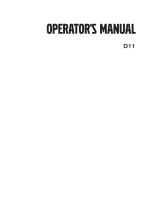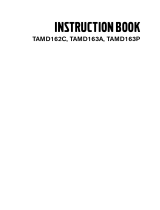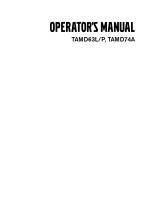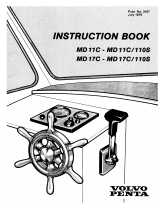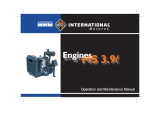Page is loading ...

The TAD734GE is a powerful, reliable
and economical Generating Set Diesel
Engine built on the dependable in-line six
design.
Durability & low noise
Designed for easiest, fastest and most
economical installation. Well-balanced to
produce smooth and vibration-free opera-
tion with low noise level.
To maintain a controlled working tem-
perature in cylinders and combustion
chambers, the engine is equipped with
piston cooling. The engine is also fitted
with replaceable cylinder liners and valve
seats/guides to ensure maximum durabil-
ity and service life of the engine.
Low exhaust emission
The state of the art, high-tech injection
and charging system with low internal
losses contributes to excellent combus-
tion and low fuel consumption.
The TAD734GE complies with EU Stage
2 exhaust emission regulations.
Easy service & maintenance
Easily accessible service and mainte-
nance points contribute to the ease of
service of the engine.
Technical description
Engine and block
– Optimized cast iron cylinder block with opti-
mum distribution of forces
– Piston cooling for low piston temperature
and reduced ring temperature
– Drop forged steel connecting rods
– Crankshaft hardened bearing surfaces and
fillets for moderate load on main and big-
end bearings
– Keystone top compression rings for long
service life
– Replaceable valve guides and valve seats
– Three PTO positions at flywheel end
– Lift eyelets
– Flywheel housing with connection acc. to
SAE 2
– Flywheel for flexplate
– Fixed integrated radiator front engine sus-
pension
– Transport brackets, rear
Lubrication system
– Full flow cartrigde insert filter
– Rotary displacement oil pump driven by the
crankshaft
– Deep front oil sump
– Oil filler on top
– Oil dipstick, short in front
– Integrated full flow oil cooler, side-mounted
Fuel system
– Common rail
– Gear driven fuel feed pump
– Six hole fuel injection nozzles
– Electronic governor
– Fuel prefilter with water separator
– Fine fuel filter of cartridge insert type
Intake and exhaust system
– Connection flange for exhaust line
– Waste gate turbo charger, centre low with
exhaust flange
– Two-stage air filter, with cyclon
– Heater flange in charge air inlet (with relay)
Cooling system
– Belt driven, maintenance-free coolant pump
with high degree of efficiency
– Efficient cooling with accurate coolant con-
trol through a water distribution duct in the
cylinder block
– Reliable thermostat with minimum pressure
drop
– Pusher fan
Electrical system
– Engine Management System 2 (EMS 2), an
electronically controlled processing system
which optimizes engine performance. It also
includes advanced facilities for diagnostics
and fault tracing
– The instruments and controls connect to the
engine via the CAN SAE J1939 interface,
either through the Control Interface Unit
(CIU) or the Display Control Unit (DCU).
The CIU converts the digital CAN bus signal
to an anolog signal, making it possible to
connect a variety of instruments. The DCU is
a control panel with display, engine control,
monitoring, alarm, parameter setting and di-
agnostic functions. The DCU also presents
error codes in clear text.
– Sensors for oil pressure, boost pressure,
boost temp, exhaust temp, coolant temp,
water in fuel, fuel pressure and two speed
sensors.
Features
– Electronic governing, EMS2
– CAN bus communication
– Compact design for the power class
– High power to weight ratio
– Emission compliant
– Noise optimized engine design
– Dual speed
VOLVO PENTA INDUSTRIAL DIESEL
TAD734GE
250kW (340 hp) at 1500 rpm, 263 kW (357 hp) at 1800 rpm, acc. to ISO 3046

Power Standards
The engine performance corresponds to ISO 3046, BS
5514 and DIN 6271. The technical data applies to an engine
without cooling fan and operating on a fuel with calorific value
of 42.7 MJ /kg (18360 BTU/lb) and a density of 0.84 kg/liter
(7.01 lb/US gal), also where this involves a deviation from
the standards. Power output guaranteed within 0 to +2% att
rated ambient conditions at delivery. Ratings are based on
ISO 8528.
Engine speed governing in accordance with ISO 3046/IV,
class A1 and ISO 8528-5 class G3
Exhaust emissions
The engine complies with EU stage 2 emission legislation
according to the Non Road Directive EU 97/68/EC.
Rating Guidelines
PRIME POWER rating corresponds to ISO Standard Power for
continuous operation. It is applicable for supplying electrical power
at variable load for an unlimited number of hours instead of com-
mercially purchased power. A10 % overload capability for govering
purpose is available for this rating.
MAXIMUM STANDBY POWER rating corresponds to ISO Stan-
dard Fuel Stop Power. It is applicable for supplying standby electri-
cal power at variable load in areas with well established electrical
networks in the event of normal utility power failure. No overload
capability is available for this rating. 1 hp = 1 kW x 1.36
Information
For more technical data and information, please look in the Gener-
ating Set Engines Sales Guide.
http://www.brizmotors.ru/equipment/ctm/
v250a/
TAD734GE
Technical Data
General
Engine designation ...........................................................................TAD734GE
No. of cylinders and configuration ........................................................in-line 6
Method of operation ................................................................................4-stroke
Bore, mm (in.) ......................................................................................108 (4.25)
Stroke, mm (in.) ...................................................................................130 (5.12)
Displacement, l (in³).......................................................................7.15 (436.0)
Compression ratio ..........................................................................................17:1
Dry weight, excl. cooling system, kg (lb) .................................... 764 (1684)
Wet weight, excl. cooling system, kg (lb) ....................................788 (1737)
Performance 1500 rpm 1800 rpm
with fan, kW (hp) at:
Prime Power 213 (290) 216 (294)
Max Standby Power 238 (324) 243 (330)
Lubrication system 1500 rpm 1800 rpm
Oil consumption, liter/h (US gal/h) at:
Prime Power 0.03 (0.008) 0.03 (0.008)
Max Standby Power 0.03 (0.008) 0.03 (0.008)
Oil system capacity incl filters, liter ............................................................... 29
Fuel system 1500 rpm 1800 rpm
Specific fuel consumption at:
Prime Power, g/kWh (lb/hph)
25 % 244 (0.396) 257 (0.417)
50 % 233 (0.378) 237 (0.384)
75 % 217 (0.352) 222 (0.360)
100 % 204 (0.331) 205 (0.332)
Max Standby Power, g/kWh (lb/hph)
25 % 247 (0.400) 259 (0.420)
50 % 235 (0.381) 239 (0.387)
75 % 217 (0.352) 225 (0.365)
100 % 205 (0.332) 207 (0.336)
Intake and exhaust system 1500 rpm 1800 rpm
Air consumption at 27°C, m³/min (cfm):
Prime Power 16.1 (569) 18.3 (646)
Max Standby Power 16.3 (576) 18.9 (667)
Max allowable air intake restriction,
kPa (In wc) 3.0 (12.0) 3.0 (12.0)
Heat rejection to exhaust,
kW (BTU/min) at:
Prime Power 160 (9099) 174 (9895)
Max Standby Power 177 (10066) 189 (10748)
Exhaust gas temperature after
turbine, °C (°F) at:
Prime Power 495 (923) 475 (887)
Max Standby Power 550 (1022) 510 (950)
Max allowable back-pressure in
exhaust line, kPa (In wc) 10 (40.2) 10 (40.2)
Exhaust gas flow, m³/min (cfm) at:
Prime power 33.0 (1165) 36.7 (1296)
Max Standby Power 33.4 (1180) 37.9 (1338)
Cooling system 1500 rpm 1800 rpm
Heat rejection radiation from engine,
kW (BTU/min)
Prime Power 24 (1365) 25 (1422)
Max Standby Power 26 (1479) 28 (1592)
Heat rejection to coolant kW (BTU/min)
Prime Power 117 (6654) 124 (7052)
Max Standby Power 128 (7279) 137 (7791)
Fan power consumption, kW (hp) 11.6 (16) 20.0 (27)
Standard equipment
Engine
Automatic belt tensioner
•
Lift eyelets
•
Flywheel
Flywheel housing with conn. acc. to SAE 2
•
Flywheel 10” and 11.5” disc
•
Vibration damper
•
Engine suspension
Fixed integrated radiator front engine suspension
•
Lubrication system
Oil dipstick
•
Full-flow oil filter of cartridge type
•
Oil cooler, side mounted
•
Fuel system
Common rail
•
Fuel filters of cartridge type •
Pre-filter with water separator
•
Intake and exhaust system
Two-stage air filter with cyclon
•
Connecting flange for exhaust pipe
•
Turbo charger, low left side
•
Cooling system
Tropical radiator incl intercooler
•
Belt driven coolant pump
•
Fan hub
•
Pusher fan
•
Fan guard
•
Belt guard
•
Control system
Engine Management System (EMS) with CAN-bus
interface SAE J1939 and stand alone interface
•
Alternator
Alternator 100A / 24 V
•
Starting system
Starter motor, 5.0kW, 24 V
•
Instruments and senders
Temp.- and oil pressure for automatic
stop/alarm
•
Engine Packing
Plastic wrapping
•
1)
must be ordered, se order specification
− optional equipment or not applicable
• included in standard specification
Note! Not all models, standard equipment and accessories are available in all countries.
All specifications are subject to change without notice.
The engine illustrated may not be entirely identical to production standard engines.
English 11-2011. © 2011 AB Volvo Penta
1320
1858
1651
1050
Dimensions TAD734GE
Not for installation

OPERATOR’S MANUAL
9 Liter (EMS 2)
Volvo TAD734GE

Presentation
Engines
This Operator's Manual contains descriptions and
maintenance instructions for TAD940GE, TAD941GE,
TAD940VE, TAD941VE, TAD942VE, TAD943VE,
TAD950VE, TAD951VE and TAD952VE industrial die-
sel engines.
They are 6-cylinder in-line engines with direct injection.
All engines are equipped with electronically controlled
fuel management (EMS 2), turbocharger, charge air
cooler, thermostatically controlled cooling systems
and electronic speed control.
TAD950VE, TAD951VE have TAD952VE are also
equipped with internal EGR (Exhaust Gas Recircula-
tion).
47702660 03-2013 © AB VOLVO PENTA 9

EMS (Engine Management
System)
EMS (Engine Management System) is an electronic system with CAN communication (Controller Area Network)
for diesel engine control. The system was developed by Volvo Penta and includes fuel control and diagnostic
function.
Input signals
The control unit receives input signals about engine
operating conditions, etc. from the following compo-
nents:
- coolant temperature sensor
- charge air pressure and charge air temperature
sensor
- crankcase pressure sensor
- position sensor, camshaft
- speed sensor, flywheel
- coolant level sensor
- oil level and temperature sensor
- oil pressure sensor
- fuel pressure sensor
- water in fuel indicator
Output signals
The control module uses input signals to control the
following components:
- unit injectors
- starter motor
- main relay
- pre-heating relay
Information from the sensors provides exact informa-
tion about current operation conditions and allows the
processor in the control unit to calculate the correct
fuel injection volume and timing, check engine status
etc.
Diagnostics function
The purpose of the diagnostic function is to detect and
locate any malfunctions in the EMS system, to protect
the engine and to ensure operation in the event of
serious malfunction.
If a malfunction is detected, it is announced by warn-
ing lamps, a flashing diagnostic lamp or in plain lan-
guage on the instrument panel, depending on the
equipment used. If a fault code is provided as a flash-
ing code or in plain language, it is used for guidance
in any fault tracing. Fault codes can also be read by
Volvo's Vodia tool at authorized Volvo Penta work-
shops.
If there is a serious malfunction, the engine will be
shut down altogether, or the control unit will reduce
the power delivered (depending on the application).
Once again, a fault code is set for guidance in any
fault tracing.
Fuel control
The engine fuel requirement is analyzed up to 100
times per second. The amount of fuel injected into the
engine and the injection advance are fully electroni-
cally controlled via fuel valves in the unit injectors.
This means that the engine always receives the cor-
rect volume of fuel in all operating conditions, which
offers lower fuel consumption, minimal exhaust emis-
sions etc.
Presentation
10 47702660 03-2013 © AB VOLVO PENTA

Instruments and Controls
DCU (Display Control Unit)
The DCU control panel is available as an optional
accessory for the EMS (Engine Management System)
electronic control system.
The DCU is a digital instrument panel which commu-
nicates with the engine control unit. The DCU has sev-
eral functions, such as engine control, monitoring,
diagnostics, and parameter setting.
The menus in the DCU system can be used to check,
and in some cases to set, a number of different func-
tions in the EMS system.
NOTICE! Settings and what engine data that appears
in the display may vary depending on installation and
engine model.
NOTICE! The menus and illustrations shown here are
the English version. The language can be changed,
however; refer to the Setup menu.
1
2
3
4
5
6
7
8
9
10
P0002062
Start
When the DCU panel is started, the “Engine Data” menu is displayed; press “ESC” to come to the main menu.
1 LED display 6 ON/OFF. Starts and stops the system
2 START. Starts the engine 7 Scroll downwards in menus
3 SPEED - . Reduces engine rpm 8 SEL. Selects in menus
4 SPEED +. Increases engine rpm 9 Scroll upwards in menus
5 STOP. Stops the engine 10 ESC. Return to previous menu selection
47702660 03-2013 © AB VOLVO PENTA 11

Menus
There are several sub-menus under each main menu.
There is not space for all the menu choices on the dis-
play. To scroll through the menus, use the 7 and 9
buttons on the display. Press the SEL button 8 to make
a selection. Refer to the illustration on the previous
page.
NOTICE! The Setup menu can be used to select the
language that you want to use on the display.
Main menu
•
Engine data, current engine data
•
Preheat, manual activation of pre-heating. Must be
activated with temperatures below 0°C (32°F)
•
Governor mode, activation of droop
•
Diagnostics, shows fault codes as text
•
Trip reset, resets trip data
•
Setup, parameter setting
•
Information, shows the currently applicable hard/
software, data sets and engine identification for the
engine and DCU data
Engine data
shows relevant engine data.
•
Engine speed, can be controlled with the SPEED+
and SPEED– buttons (rpm)
•
Charge pressure (kPa)
•
Coolant temperature (°C)
•
Charge air temperature (°C)
•
Oil pressure (kPa)
•
Oil temperature (°C)
•
Engine hours (h)
•
Battery voltage (V)
•
Fuel consumption (l/h)
•
Instantaneous fuel consumption (trip fuel) (l)
Instruments and Controls
12 47702660 03-2013 © AB VOLVO PENTA

Preheat
manual activation of pre-heating. When it is activated,
the EMS system senses at start-up if pre-heating is
needed. For automatic pre-heating, refer to the Setup /
Preheat on ignition menu.
NOTICE! Must be activated with temperatures below
0°C (32°F).
The pre-heating time is adjusted to suit the engine
temperature, and can last for up to 50 seconds both
before and after starting. Refer also to Starting proce-
dure EMS 2.
•
Press SEL, the text Preheat requested will be
shown
•
The display automatically returns to the Engine
Data menu.
Governor mode
activates/shuts off droop. To set the droop level, refer
to the Setup / Governor gradient or Governor droop
menu.
•
Select Isochronous mode or Droop mode with the
SEL button.
Diagnostics
shows the error list containing the 10 latest active and
inactive faults. The fault codes are shown as text on
the display.
•
Scroll through the fault list with the arrow keys.
Trip Data reset
resets trip data, such as fuel consumption.
•
Press the SEL button to reset trip data
Instruments and Controls
47702660 03-2013 © AB VOLVO PENTA 13

Setup
parameter setting in the engine's control systems. Dif-
ferent menus appear under Customer parameter,
depending on whether Versatile or Gen set has been
selected from Set application. See below.
The parameters that can be set/selected (choice is
made with the SEL button) are:
•
Set application, setting Versatile or Gen set.
Depending on the selection made here, different
menus will appear under Customer parameter.
•
Unit, setting of units (metric or US imperial).
•
Language, setting the language used on the dis-
play. Choose between English, French, German
and Spanish.
•
Stop energized to, setting of external stop input.
Activated by Stop or Run.
Stop: The stop input must be connected to voltage
to stop the engine.
Run: The stop input must be connected to voltage
to run the engine.
•
Customer parameter, setting alarm limits. Refer to
Customer parameter / Versatile and Customer
parameter / Gen set.
•
Throttle input setting, setting of engine-speed
control and voltage limits. Refer to Throttle input
setting.
•
Display setting, setting the display. refer to Display
setting.
Customer parameter / Versatile
•
Idle engine speed - setting idle speed.
•
Preheat on ignition - activation of automatic pre-
heating. The engine control system senses if pre-
heating is needed and activates it directly at switch-
on.
•
Governor gradient (Nm/rpm) - setting of droop
level, when activated. For activation, refer to Gov-
ernor droop in the main menu.
•
Oil temp warning limit (°C) - setting alarm limit for
oil temperature.
•
Coolant temp warning limit (°C) - setting alarm
limit for coolant temperature.
Instruments and Controls
14 47702660 03-2013 © AB VOLVO PENTA

Customer parameter / Gen set
•
Primary engine speed - selection of engine rpm,
1500 or 1800 rpm.
•
Preheat on ignition - activation of automatic pre-
heating. The engine control system senses if pre-
heating is needed and activates it directly at switch-
on.
•
Governor droop (%) - setting of droop level, when
activated. For activation, refer to “Governor droop”
in the main menu.
•
Overspeed limit (%) - setting of limit for overspeed
alarm, % of set engine rpm.
•
Overspeed shutdown - activation of engine shut-
down with overspeed alarm. Refer to “Overspeed
limit” to activate the alarm limit for the excess rpm
alarm.
•
Oil temp warning limit (°C) - setting alarm limit for
oil temperature.
•
Coolant temp limit (°C) - setting alarm limit for
coolant temperature.
Throttle input setting
rpm control setting (throttle operation).
•
Set throttle mode - OFF - engine rpm is controlled
via the DCU panel.
ext throttle input - engine speed is controlled with a
potentiometer (accelerator).
ext voltage input - engine rpm is controlled by an
external unit.
•
Set idle voltage (V) - idle voltage level setting.
•
Set max voltage (V) - full throttle voltage level set-
ting.
Instruments and Controls
47702660 03-2013 © AB VOLVO PENTA 15

Display setting
settings for the display. Adjustment is made with the 7
and 9 buttons; see DCU panel illustration.
•
Set contrast (%) - contrast setting.
•
Set backlight time (sec) - time setting (in seconds)
for display backlighting on, lighting is then shut off if
the panel is not used.
•
Set backlight brightness - display backlighting
brightness setting.
Information
shows the data for the engine and DCU.
•
Engine hardware Id - engine control unit part num-
ber.
•
Engine software Id - engine control unit software
part number.
•
Engine dataset1 Id - engine data set 1 part number.
•
Engine dataset2 Id - engine data set 2 part number.
•
Vehicle Id - chassis number.
•
DCU hardware Id - DCU part number.
•
DCU software Id - DCU software part number.
•
DCU dataset1 Id - DCU data set 1 part number.
•
DCU dataset2 Id - DCU data set 2 part number.
Instruments and Controls
16 47702660 03-2013 © AB VOLVO PENTA

DU (Display Unit)
The DU is an computerized instrument panel which
shows engine working values on an LCD screen. In the
display it is possible to show multiple windows with dif-
ferent information, i. g. engine rpm, coolant tempera-
ture, fuel consumption and fault messages.
At start up, the display performs a self-test. If an con-
stant signal is heard, the system has discovered a mal-
function. The display will work but may act in an unex-
pected way.
The DU is connected between the engine control unit
and the CIU or DCU.
Display modes
Press any of button 1–4 to view the function menu for
the buttons, apperaring in the lower part of the display.
To leave the menu, wait a few seconds or press button
5 (EXIT).
1 Engine
2 Multi
3 Trip
4 Graph
5 Exit
Contrast
In the display modes Engine, Trip and Graph, it is pos-
sible to adjust the contrast.
Press button 5 outside the menu and then + (button 4)
or – (button 3) to adjust the contrast.
P0002061
Instruments and Controls
47702660 03-2013 © AB VOLVO PENTA 17

Engine
Rpm and coolant temperature is shown in the upper
part of the display. In the lower part it will show trip
computer and a fuel level indicator, if these function are
installed.
Multi
In the multi mode, button 2, the information can be
shown in four windows,analogue or digital. The display
toggles between the two when button 2 is pressed
repeatedly.
By pressing button 5, the right arrow, you choose what
information to be shown in the different windows.
Press repeatedly on the button that correspond to the
window, until desired information is shown.
Trip
To display the trip computer press button 3, Trip
Trip Fuel, since last reset
Fuel Rate, fuel consumption
Trip hours, since last reset
Engine hours, total amount of operating hours
Reset by pressing button 3 for three seconds until a
beep is heard.
Graph
The information is shown as graphs. Press button 4
repeatedly to choose what information will be shown.
The time interval is set in the Configuration menu.
If the connection is broken there will be a straight line
in the display.
Instruments and Controls
18 47702660 03-2013 © AB VOLVO PENTA

Configuration menu
Press button 5 for three seconds to enter the Config-
uration menu. Navigate with the up and down arrows,
select with the right arrow.
Units
- PRESSURE; kPa, PSI
- VOLUME; LITRE, GAL, Imperial GAL.
Fuel rate is adjusted according to volume unit, L/H,
GAL/H, IGAL/H.
- TEMPERATURE; °C, °F
Alarm Status
List of active alarms, refer to Fault
Handling page 34
Instruments and Controls
47702660 03-2013 © AB VOLVO PENTA 19

Settings
- LANGUAGE; setting of what language is to be used
in the display.
- BLEEP; On/Off, setting if pressing the instrument
buttons will be followed by a beep or not.
- DISPLAY; setting of ENGINE RPM gauges
RPM ENGINE, 2500–9000 RPM, in steps of 500
RPM
GRAPH RANGE, 2 minutes– 8 hours in the follow-
ing steps,
2MINS, 10MINS, 30MINS, 60MINS, 2HRS, 4HRS,
8HRS
SYSTEM
- DEMO, switches the DEMO mode ON/OFF.
- RESTORE DEAFAULTS, reset all configuration to
default values.
- COM VIEWER, displays latest message on com-
munication ports
- PROG TX, transfers content of the application on
Flash memory to other CAN units on the same CAN
bus.
- ABOUT, displays
ID NO – display serial number
EEPROM – number of write on EEPROM
VERS – software version number
CHK – Flash memory checksum
PART No – Volvo software part number
SOURCE – source of received data
LABLE – Allocated Label on the same bus.
Instruments and Controls
20 47702660 03-2013 © AB VOLVO PENTA

CIU (Control Interface Unit)
The CIU is a "translator" between the control unit
(EMS) and the customer's own control panel. The CIU
has two serial communication links, one fast and one
slow.
The fast one is a so-called CAN link. All data related to
instruments, indication lamps, connectors and poten-
tiometers is controlled by this link.
The slow link manages diagnostic information for flash-
ing codes etc.
Easy Link Instruments
The following Easy Link instruments are available:
- Tachometer / hours counter (fault codes are also
displayed on the tachometer display when the diag-
nostic button is pressed)
- Coolant temperature
- Oil pressure
- Oil temperature
- Battery voltage
- Alarm panel
- Turbo pressure
P0002060
Instruments and Controls
47702660 03-2013 © AB VOLVO PENTA 21

Starting
Make it a habit of giving the engine and engine room a visual check before starting. This will help you to discover
quickly if anything abnormal has happened, or is about to happen.
Also check that instruments and warning displays show normal values after you have started the engine.
WARNING!
Never use start spray or similar agents to start an engine. This may cause an explosion in the inlet manifold.
Danger of personal injury.
Before Starting
•
Check that the oil level is between the MIN and MAX
marks.
NOTICE! The oil level can be read both when the
engine is stopped (the STOP side of the dipstick) and
with the engine running (the OPERATING side of the
dipstick).
For filling refer to Oil level, checking and topping up.
•
Open the fuel valves.
•
Check the fuel pre-filter; refer to Draining conden-
sate, fuel system page 51.
•
Check the coolant level and that the radiator is not
blocked externally. Refer to Coolant Level, Check-
ing and Topping Up page 54 and Charge Air
Cooler, External Cleaning page 55
WARNING!
Do not open the coolant filler cap when the engine
is warm, except in emergencies, this could cause
serious personal injury. Steam or hot fluid could
spray out.
•
Check that no leakage of oil, fuel or coolant is
present.
•
Turn the main switch(es) on.
•
Move the engine speed control to idle, and open the
disengageable clutch/gearbox if installed.
IMPORTANT!
Never break the circuit with the main switch while the
engine is running, as this may damage the alternator.
STOP
OPERATING
P0004311
P0002078
22 47702660 03-2013 © AB VOLVO PENTA

Starting the Engine
EMS (Engine Management System)
The pre-heating time is adjusted to suit the engine
temperature, and can last for up to 50 seconds both
before and after starting.
The starter motor connection time is maximized to 20
seconds. After that, the starter motor circuit is cut for
80 seconds to protect the starter motor against over-
heating.
DCU (Display Control Unit)
With pre-heating
1 Depress the ON/OFF-button (6).
2 Press the SEL button (8) to come to the main-
menu.
3 Scroll down to Pre/heater with scroll button
(7),press SEL-button (8)
4 In the pre-heater menu, press the SEL-button
(8) to select pre-heating.
5 Press the START- button (2).
Without pre-heating
1 Depress the ON/OFF-button (6).
2 Press the START-button (2).
Leave the engine to idle for the first 10 seconds. Then
warm the engine up at low speed and under low load.
Never race the engine when it is cold.
Starting
47702660 03-2013 © AB VOLVO PENTA 23

Starting in Extreme Cold
Certain preparations must be made to facilitate engine
starting, and in some cases to make starting possible
at all:
•
Use a winter grade fuel (of a well-known make)
which has been approved for the relevant tempera-
ture. This reduces the risk of wax deposits in the fuel
system. At extremely low temperatures, the use of
a fuel heater is recommended.
•
For fully acceptable lubrication, a synthetic engine
oil of recommended viscosity for the relevant tem-
perature should be used. Please refer to the Main-
tenance, lubrication system chapter. Synthetic lubri-
cants are able to manage a wider temperature range
than mineral-based lubricants.
•
Pre-heat the coolant with a separately installed ele-
tric engine heater. In extreme cases, a diesel-burn-
ing engine heater may be needed. Ask your Volvo
Penta dealer for advice.
•
Make sure that the cooling system is filled with a
glycol mixture. Please refer to the Maintenance,
cooling system chapter.
•
The batteries should be in good condition. Cold
weather reduces battery capacity. Increased battery
capacity may be necessary.
Never Use Start Spray
WARNING!
Never use start spray or similar agents to start an
engine. This may cause an explosion in the inlet mani-
fold. Danger of personal injury.
P0002080
Starting
24 47702660 03-2013 © AB VOLVO PENTA

Starting Using Auxiliary Batteries
WARNING!
Explosion hazard. Batteries contain and give off an
explosive gas which is highly flammable and explosive.
A short circuit, open flame or spark could cause a vio-
lent explosion. Ventilate well.
1 Check that the auxiliary batteries are connected
(series or parallel) so that the rated voltage corre-
sponds to the engine system voltage.
2 First connect the red (+) jumper cable to the auxili-
ary battery, then to the flat battery. Then connect
the black (-) jumper cable to the auxiliary battery
and to a location that is somewhere away from the
discharged battery, e.g. the main switch negative
terminal or the negative terminal on the starter
motor.
3 Start the engine.
WARNING!
Do not touch the connections during the start
attempt: Risk of arcing.
Do not bend over any of the batteries either.
4 Remove the cables in the reverse order.
IMPORTANT!
The ordinary cables to the standard batteries must not
be loosened on any condition.
Starting
47702660 03-2013 © AB VOLVO PENTA 25
/
